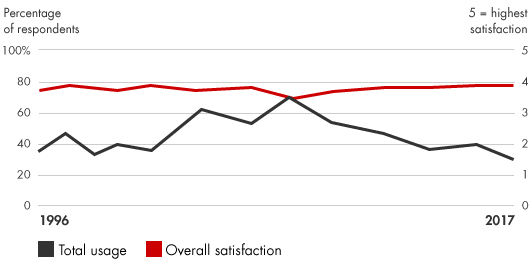Management Tools
A Balanced Scorecard defines an organization’s performance and measures whether management is achieving desired results. The Balanced Scorecard translates Mission and Vision Statements into a comprehensive set of objectives and performance measures that can be quantified and appraised. These measures typically include the following categories of performance:
- Financial performance (revenues, earnings, return on capital, cash flow)
- Customer value performance (market share, customer satisfaction measures, customer loyalty)
- Internal business process performance (productivity rates, quality measures, timeliness)
- Innovation performance (percentage of revenue from new products, employee suggestions, rate of improvement index)
- Employee performance (morale, knowledge, turnover, use of best demonstrated practices)
Usage and satisfaction among survey respondents

How a Balanced Scorecard works:
To construct and implement a Balanced Scorecard, managers should:
- Articulate the business’s vision and strategy
- Identify the performance categories that best link the business’s vision and strategy to its results (such as financial performance, operations, innovation, employee performance)
- Establish objectives that support the business’s vision and strategy
- Develop effective measures and meaningful standards, establishing both short-term milestones and long-term targets
- Ensure companywide acceptance of the measures
- Create appropriate budgeting, tracking, communication and reward systems
- Collect and analyze performance data and compare actual results with desired performance
- Take action to close unfavorable gaps
| RELATED TOPICS | HOW BAIN CAN HELP |
|---|---|
|
Companies use a Balanced Scorecard to:
- Clarify or update a business’s strategy
- Link strategic objectives to long-term targets and annual budgets
- Track the key elements of the business strategy
- Incorporate strategic objectives into resource allocation processes
- Facilitate organizational change
- Compare performance of geographically diverse business units
- Increase companywide understanding of the corporate vision and strategy

Management Tools & Trends
Five key trends emerged from Bain's survey of 1,268 managers.
Selected references
Epstein, Marc, and Jean-François Manzoni. “Implementing Corporate Strategy: From Tableaux de Bord to Balanced Scorecards.” European Management Journal, April 1998, pp. 190–203.
Kaplan, Robert S., and David P. Norton. Alignment: Using the Balanced Scorecard to Create Corporate Synergies. Harvard Business School Press, 2006.
Kaplan, Robert S., and David P. Norton. “The Balanced Scorecard: Measures That Drive Performance.” Harvard Business Review, July 2005, pp. 71–79.
Kaplan, Robert S., and David P. Norton. Strategy Maps: Converting Intangible Assets into Tangible Outcomes. Harvard Business School Press, 2004.
Kaplan, Robert S., and David P. Norton. The Strategy-Focused Organization: How Balanced Scorecard Companies Thrive in the New Business Environment. Harvard Business School Press, 2000.
Niven, Paul R. Balanced Scorecard Diagnostics: Maintaining Maximum Performance. John Wiley & Sons, 2005.
Niven, Paul R. Balanced Scorecard Evolution: A Dynamic Approach to Strategy Execution. John Wiley & Sons, 2014.
Niven, Paul R. Balanced Scorecard Step-by-Step: Maximizing Performance and Maintaining Results. 2d ed. John Wiley & Sons, 2006.